The GM Burden of Adjudicating Partial Successes
How different systems lessen the burden to improvise and help the GM balance the hard-ness of their moves
As opposed to a binary pass/fail resolution mechanic, many ttrpg systems have the option of rolls resulting in a mixed result, either success at a cost or failure with an opportunity.
This can fit better with certain genres and kinds of stories. It lets the players “fail forward” more often - meaning that the story doesn’t grind to a halt if the players fail a roll. Instead, the story is further complicated and can continue moving, even if the players didn’t fully get what they wanted.
But this can put a burden on the GM to improvise. In this article, I’ll talk about that burden and how some games use their mechanics to mitigate this.
I’m Colin, and I’m a professional video game designer. This is Drolleries, where I write about d&d, ttrpgs, and game design.
Freelance Infantry Strike Team
I ran this ttrpg called FIST, and it was a lot of fun. The players are paramilitary operatives with supernatural powers who plan and execute high-stakes covert operations, very much inspired by Metal Gear Solid. It’s rules-light but bursting with flavor, character creation was fast and inspiring with its mix-and-match traits system, and combat was deadly, with a free-flowing turn order that encourages creativity and teamwork.
But FIST’s implementation of mixed success results was difficult for me to run.
Here’s how it works. You roll 2d6, adding one of your stats (Forceful, Tactical, Creative, Reflexive).
On a 6 or below, it’s a failure. Things go wrong somehow.
On a 7-9, it’s a partial success. Things go right with a downside.
On a 10 or above, it’s a success. Things go right with no downside.
Double 6s is an ultra success. Things go right with a bonus.
Assuming you’re rolling with +1 for your stat, that’s about a 45% chance of getting a partial success on every roll.
That’s a lot - that’s almost every other roll.
This was fine in noncombat scenarios, where I called for rolls much less frequently and weighed their results more heavily. But once the players entered combat, this problem got much worse.
Balancing Partial Successes in Combat
FIST gives you guidance on how to rule partial successes in combat, but it’s not a hard rule:
Characters deal their weapon's DAMAGE (if rolling to attack) on a success and may take DAMAGE from their target on a failure. If the players are engaged in active combat (i.e. two or more parties actively, openly attempting to harm each other), rolling a failure always incurs DAMAGE.
And this is how it advises GMs handle partial successes in combat:
This really fried my brain.
Because the combat isn’t over until the enemies run out of hit points (or suffer enough casualties that they decide to retreat), the players make many rolls, one after another, in order to stab and shoot their enemies. With a 45% chance of partial success and the players making a lot of rolls, I had to improvise a lot.
There’s only so many times I can have reinforcements show up. The second time I have a player’s gun jam, it’s just annoying. Both parties dealing damage to each other just means this already-deadly game just got way deadlier. And having players deal half damage just slows down the pace of the combat and guarantees that it’s gonna take even more rolls and I’ll have to improvise even more.
I love improvising mixed successes occasionally, but in combat, it was just too much for me to keep up with, and it slowed the game way down.
That’s not to mention the power difference of these consequences. Having reinforcements show up is a huge deal, and in such a deadly game it means the players’ plan is probably ruined and someone might die if they don’t get lucky with their rolls. But having a player just trip and fall prone is comparatively not a big deal at all. How do I as the GM mete out these vastly different consequences? That was a tough question to answer, especially with so many partial successes.
Remembering Other Games I’ve Played
I compared my experience running FIST to my experience running Yokai Hunter’s Society. In Yokai Hunter’s Society, there’s a mixed success result, but it’s only on a 9 on a 2d8 roll, which is about a 10% chance. And combats only last a couple rolls, so the GM isn’t forced to improvise as often, and consequently a success with a consequence can be a big deal.
Then I remembered my experience playing Monster of the Week, which is a Powered by the Apocalypse system. These systems inspired many modern ttrpg designers to incorporate more fail-forward mixed-success results, so how did it actually work? How often was the GM forced to improvise consequences out of thin air?
Well, very rarely actually.
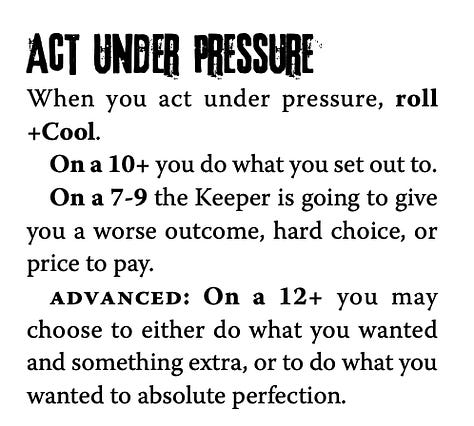
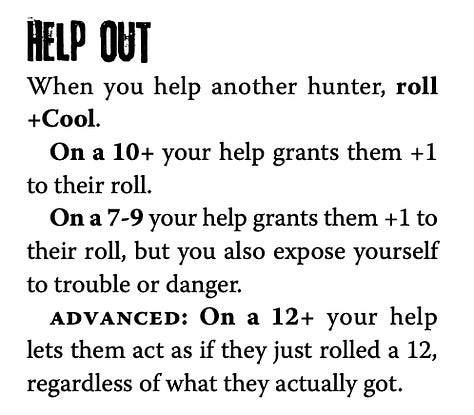
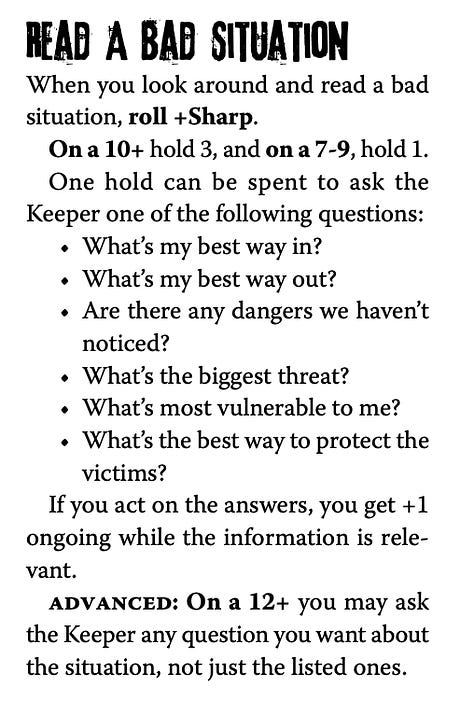
The moves in Monster of the Week actually give the GM pretty specific guidance for how to rule the 7-9 result. The most vague is for Act Under Pressure, where it says the Keeper gives the player “a worse outcome, hard choice, or price to pay.” But that’s just one of the many moves, and most of them have pretty specific guidance. Help Out says “you also expose yourself to trouble or danger.” Some moves, like Read a Bad Situation, just let you ask fewer questions on a mixed success.
This reduces the burden on the GM to invent interesting and relevant consequences, and ensures that the hard-ness of the GM move is balanced with the move the player is taking.
This unique combination in FIST of an extremely common partial success result, a combat system primarily about reducing enemy hit points, and little guidance on how to balance consequences created a huge burden for me as the GM.
Relieving the GM Burden with Metacurrencies
In Daggerheart, mixed successes are created with their hope & fear mechanic. You can succeed based on the sum of your 2d12, but if one die is greater than the other, your roll is either “with hope” or “with fear.”
On a roll with hope, something good happens and the player gains 1 hope, which is a resource they can spend on their abilities. On a roll with fear, something bad happens and the GM gains 1 fear, which is a resource they spend to make harder moves, from more and nastier monster attacks to activating environmental hazards.
Running Daggerheart, I felt much less of a burden adjudicating success-with-a-consequence or failure-with-a-boon scenarios, specifically because of these metacurrencies. If I had an idea for an interesting consequence on a roll with fear, I could make it happen. But if I couldn’t come up with something, or I wanted to take it easy on the players, I could just take the fear token and save it for later. Either way, the players still feel a sense of dread when they roll a success with fear.
Inversely, players still feel relieved when they roll a failure with hope, because at least they get a hope token to use later. I didn’t have to improvise some unrelated boon they could get, because the currency did it for me.
Daggerheart also gives direct consequences of partial successes in combat. In addition to getting a fear token on a roll with fear, the GM gets to take their turn when a player fails or succeeds with fear.
Daggerheart creates this feeling of fail-forward narrative where every roll mattered, but it didn’t rely on GM fiat to invent and balance the consequences of every roll.




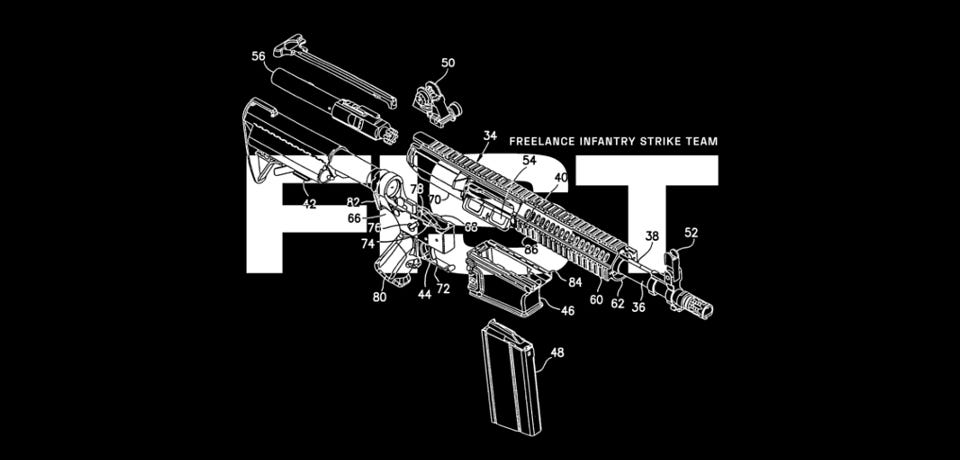
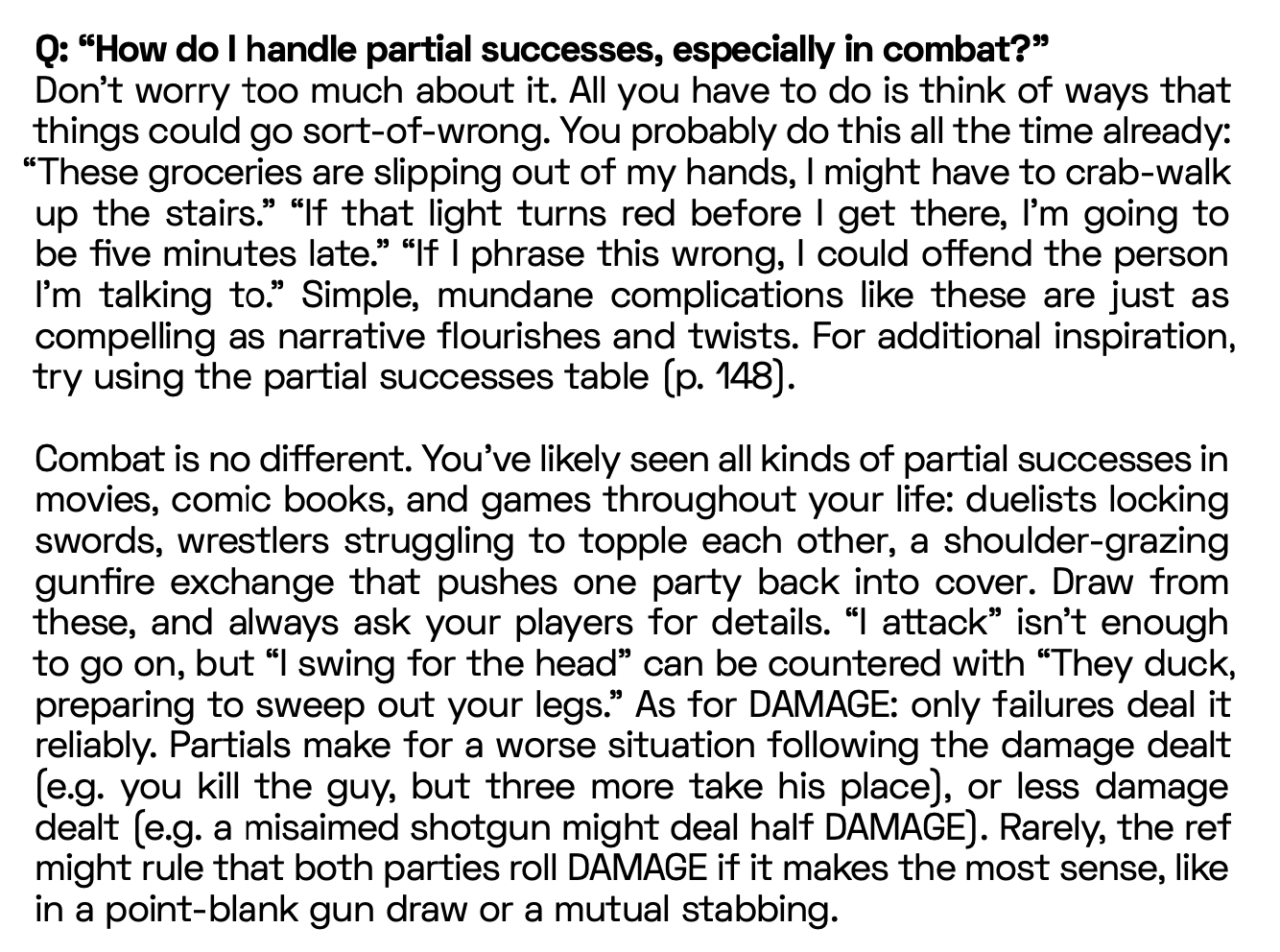
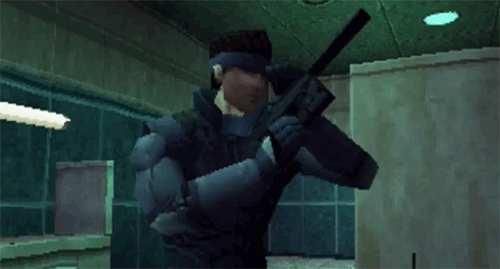

I love FIST but I also found it frustrating to run combat loosely as a conversation as the book suggests. I came up with a turn based combat system on top which turned out pretty effective. I know that pbta does not encourage such things but I also know that pbta is fairly controversial in the community.
My system is essentially: everyone gets a "main action" fighting (FOR/REF), command(TAC), distracting(CRE), escaping, etc) and a "minor action" (moving, grabbing items, etc); a partial success or failure means you get attacked; a failure in a defense test means you get full damage, a partial means half damage.
I discovered the Strong/Weak Hit while playing Solo Mörk Borg. Coming up with caveats is challenging but it blows Pass/Fail out of the water and helps drive the game away from stalemates and wasted turns.